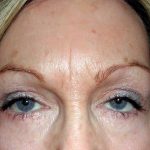
Despite the many different types of browlift surgery, they all rely on lifting the brow from a superior point at or in the hairline. Unlike a facelift where the greatest benefit comes from moving tissues closer to the point of pull, a browlift attempts to correct a structure at the furtherest point from its lifting position. This can result in unpredictable changes in the position or shape of the eyebrow.
Eyebrow lift procedures are well known to result in undesireable brow changes. Everyone recognizes the ‘deer in the headlights’ results where the eyebrows have been pulled too high. This can make one look older and give the upper lids a hollowed out appearance. Shape issues can also occur with the arc of the eyebrow becoming flat or even having a reverse arc to it. (the tail of the eyebrow should be lifted morethan the central or inner aspect of the eyebrow in women) Because the inner part of the eyebrow is easier to lift than the outer part, it is not uncommon to have an undesired brow appearance.
Another problem in browlift surgery is that it is often done when it is not needed. It is one of the few anti-aging facial procedures that is probably the most overused, done in patients in which they did not have any significant brow sagging prior to surgery.
The goal of browlift surgery should be to produce a more pleasing shape not just upward elevation. While browlift shapes have changed over the years, the most pleasing shape has been shown to be an outward arc with the tail of the brow being higher than the rest with a slightly off-center peak above the outer edge of the iris. For many patients it is the tail of the eyebrow that is down while the rest of eyebrow position and shape is just fine.
Postoperative browlift problems fall into two main categories. The first and the most common is a browlift surgery that produces little if any improvement. This is either the result of inadequate mobilization or elevation of the brow tissues or inadequate or unstable fixation of the elevated tissues. Regardless of the reason why, most patients do not really want to go through another procedure. If they do, a different browlift method should be chosen. Failure of adequate elevation is usually seen in the tail of the eyebrow as it is harder to elevate and lacks a solid bony anchorage point like the other 2/3s of the brow.
The second category is that of an undesireable brow shape. It is almost always because one portion of the brow is elevated too high. This is most common with too much inner brow elevation. Time will likely help the brow drop somewhat and this can also be aided or accelerated with Botox injections to the frontalis muscle above it. This can help push the brow down somewhat and with time it may become a self-solving problem. If the brow remains too high, a secondary subperiosteal release with tacking the brow down in a lower position can usually make an adequate correction.
Dr. Barry Eppley
Indianapolis, Indiana



